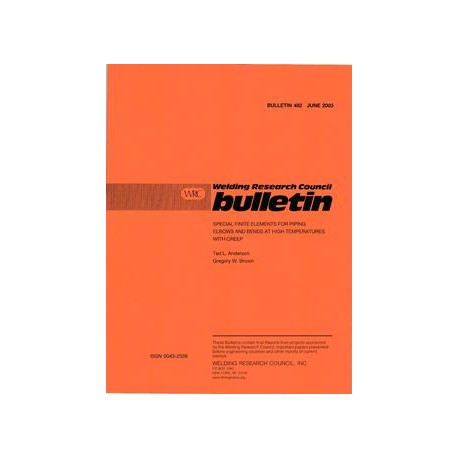Cart 0 Product Products (empty)
No products
To be determined Shipping
$0.00 Total
Product successfully added to your shopping cart
Quantity
Total
There are 0 items in your cart. There is 1 item in your cart.
Total products
Total shipping To be determined
Total
New Reduced price!  View larger
View larger
 View larger
View larger WRC 482
M00004883
New product
WRC 482 Special Finite Elements for Piping Elbows and Bends at High Temperatures with Creep
Bulletin / Circular by Welding Research Council, 2003
T. L. Anderson, G. W. Brown
In stock
More info
Full Description
Remaining life of a component in the creep range is highly sensitive to the applied stress. Accurate stress analysis is crucial to a meaningful life estimate of seam welded piping systems, in particular. There, system loads can be shown to greatly affect the life of longitudinal as well as girth welds. Typical commercial piping programs use simple beam finite elements, which do not adequately characterize the stress distributions that can occur in real piping systems. To support advanced work in life prediction of welded piping systems it has been necessary to develop superior stress analysis tools that examine displacements, creep and relaxation in even the most complex piping systems. The methodology described herein was necessary to the development of one such life assessment program.Due to the complexity of geometries and loading of piping systems, a detailed three-dimensional finite element analysis of the entire system is not convenient. This is especially daunting for piping elbows experience that complex deformation modes such as ovalization and warping. The need to perform stress analysis of piping systems both effectively and economically has led to the development of a number of special finite elements. Bathe and Almeida were the first to develop a simple and effective elbow element. This element begins with a beam model, and the ovalization of the curved pipe is described by finite Fourier series following Von Karman's work. This element presented some limitations and did not properly describe the response of an elbow under thermal load. Moreover, pressure loads were not explicitly included in the Bathe-Almeida element. Recently, Yan extended the Bathe-Almeida element to describe more accurately the behavior of a piping elbow under thermal and pressure loads. They also implemented the work of Militello and Huespe to integrate the warping of the cross section. By integrating these recent developments a sophisticated finite elements for both elbows and straight pipe sections were developed. In this report, the equations that define the elbow element and straight pipe element are presented. It is shown how the ovalization, warping, and pressure effect are integrated. To appreciate the effectiveness of the elbow element, the response of this element under different type of loads to 3D finite element models consisting of shell and brick elements are compared. These results demonstrate the potential of this particular element to analyze an entire piping structure in the creep range.

